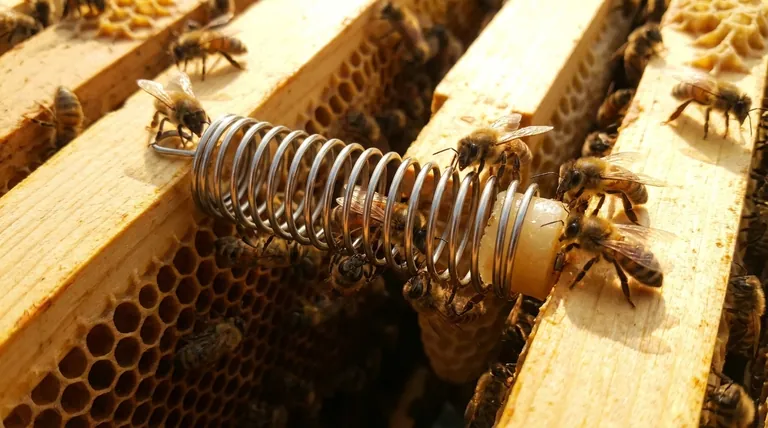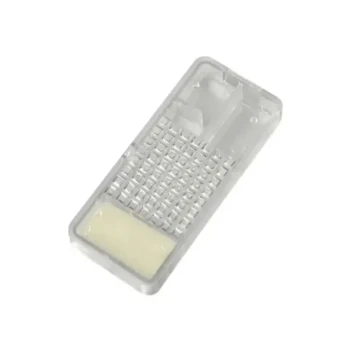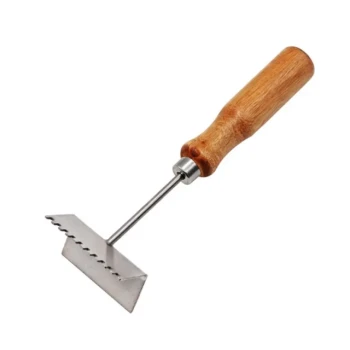A queen cage is a small enclosure, typically made of wire gauze and plastic or wood, designed to safely introduce a new queen bee to an existing colony. It works by protecting the new queen while allowing the hive's worker bees to gradually become accustomed to her unique scent, or pheromones, over several days before she is released.
The primary purpose of a queen cage is not merely to contain the queen, but to facilitate a slow, controlled introduction. It leverages time and scent to overcome a colony's natural instinct to reject and kill a foreign queen, ensuring a peaceful transition of power.

The Core Problem: Why a Hive Rejects a New Queen
A beehive is a complex society governed almost entirely by chemical signals, primarily pheromones. A new queen represents a direct threat to this established order.
The Hive's Unique Scent
Every colony has a unique scent profile, dictated by the pheromones of its resident queen. This scent is shared among all members and acts as a hive-wide identifier.
Any bee without this specific scent, especially a new queen with her own powerful pheromones, is immediately identified as a foreign intruder.
The Colony's Defensive Instinct
The worker bees' primary instinct is to protect their colony and their existing queen (or their "queenless" state). When a foreign queen is introduced abruptly, the workers will attack her, a process known as "balling," where they surround her and generate heat until she dies.
How a Queen Cage Solves the Acceptance Problem
The queen cage is an elegant solution that manipulates the bees' own biology to ensure a successful introduction.
A Protective Barrier
The cage's mesh screen is the key. It creates a physical barrier that prevents the worker bees from harming the queen while she is most vulnerable.
Pheromone Exchange
The screen allows the new queen's pheromones to slowly circulate throughout the hive. It also allows worker bees to approach the cage, touch her with their antennae, and even feed her, all of which accelerates the scent-acclimation process.
The Candy Plug: A Timed Release
Most modern queen cages have a small tube at one end filled with a hard sugar candy. This candy plug blocks the exit.
The worker bees on both the inside and outside of the cage will begin to eat the candy. This process takes anywhere from three to seven days.
Gradual, Natural Release
By the time the bees have chewed through the candy plug to release her, they have been fully exposed to her scent for days. Her pheromones are now familiar, and the colony accepts her as their new queen. The release feels like the colony's own decision, not a forced event.
The Step-by-Step Introduction Process
Using a queen cage is straightforward but requires patience.
1. Ensure the Hive is Queenless
Before introducing a new queen, you must be certain the old one is gone. It's best practice to wait at least 24 hours after removing the old queen to allow the colony to fully recognize its queenless state.
2. Place the Cage in the Hive
Gently wedge the queen cage between two frames in the center of the brood box, where the young bees are. Make sure the candy-plug end is accessible to the bees.
3. Do Not Disturb
This is the most critical step. After placing the cage, close the hive and leave it alone for at least one week. Opening the hive too early can cause stress and disrupt the delicate acceptance process.
Common Pitfalls to Avoid
While effective, the process can fail if not done correctly.
Checking Too Soon
A beekeeper's curiosity is the biggest threat. Disturbing the hive can cause the bees to become agitated and potentially reject the queen even after they have begun to accept her.
Ignoring an Existing Queen
If you misidentify the hive as queenless and there is still a reigning queen or even a hidden virgin queen, the workers will never accept the newcomer. The introduced queen will be killed as soon as she is released.
Damaging the Candy Plug
Be careful not to poke a hole in the candy plug or give the bees too much of a head start. The slow release is essential; a premature release can result in the queen's death.
Making the Right Choice for Your Goal
Understanding the principle behind the queen cage allows you to apply it effectively to different beekeeping scenarios.
- If your primary focus is requeening an aggressive hive: The slow, controlled release is the only reliable method to introduce new, calmer genetics without total colony collapse.
- If your primary focus is installing a new package of bees: The queen cage is the standard, essential tool for ensuring the thousands of unrelated bees coalesce around the new queen to form a productive colony.
- If your primary focus is making a hive split: The cage allows you to introduce a mated queen to a queenless split, bypassing the several weeks it would take for them to raise a new queen on their own.
Properly using a queen cage transforms one of the most delicate tasks in beekeeping into a predictable and highly successful operation.
Summary Table:
| Key Aspect | Purpose & Function |
|---|---|
| Primary Use | Safely introduce a new queen to an existing or new colony. |
| Core Mechanism | Allows gradual scent (pheromone) exchange between the queen and worker bees. |
| Critical Component | Candy plug provides a timed release over 3-7 days. |
| Key Benefit | Overcomes the colony's instinct to kill a foreign queen, ensuring acceptance. |
Ensure successful hive management with professional-grade equipment from HONESTBEE.
Whether you are a commercial apiary requeening dozens of hives or a distributor supplying beekeepers, the right tools are critical for success. HONESTBEE supplies durable, reliable queen cages and other essential beekeeping supplies through our wholesale-focused operations, helping you conduct smooth, stress-free queen introductions every time.
Contact HONESTBEE today to discuss your wholesale needs and elevate your beekeeping operations.
Visual Guide

Related Products
- Durable Galvanized Steel Spring Queen Bee Cage
- Professional Queen Bee Introduction and Transport Cage
- No Grafting Queen Rearing Kit: System for Royal Jelly Production and Queen Rearing
- Jenter Queen Rearing Kit Complete Set for Bee Breeding
- Nicot Queen Rearing Kit for Beekeeping and Grafting in Nicot System
People Also Ask
- Why is it important to remove burr comb around the queen cage? Ensure Hive Health and Manageability
- How should you remove the queen cage from the hive? Ensure a Successful Queen Introduction
- How should a queen cage be maintained over time? Ensure Queen Introduction Success
- When are queen cages typically used in beekeeping? Ensure a Successful Queen Introduction
- How long does it typically take bees to adjust to a new queen? Master the 2-7 Day Acceptance Window



















